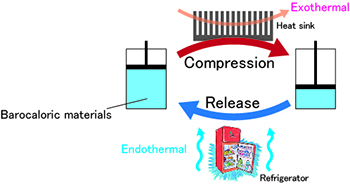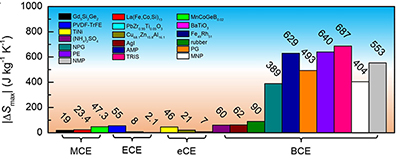| March 29, 2019 |
| |
| Pressure Makes Best Cooling |
| |
| |
Phase transitions take place with heat (i.e., entropy) exchanged between materials and environments. When such processes are driven by pressure, the induced cooling effect is called the barocaloric effect, which is a promising alternative to the conventional vapor compression cycle. For the purpose of real application, it is desirable for a material to have larger entropy changes induced by smaller pressure. Figure 1 shows the schematic diagram of the refrigeration cycle based on the barocaloric effects.
|
Recently, an international research team led by Prof. LI Bing from the Institute of Metal Research, Chinese Academy of Sciences has found that a class of disordered materials, called plastic crystals, exhibit record-large barocaloric effects under very weak pressure. The typical entropy changes are about several hundred joule per kilogram per kelvin, which is ten times better than the previous materials. The comparison of the reported materials with current leading caloric materials is highlighted in Figure 2.
|
Accessing large-scale facilities in Japan (J-PARC and SPring-8) and Australia (ANSTO) to utilize neutron scattering and synchrotron X-ray diffraction techniques, the team revealed that the constituent molecules of these materials are extensively orientationally disordered on the lattices and these materials are intrinsically very deformable. As a result, a tiny amount of pressure is able to suppress the extensive orientational disorder to induce the phase transitions to the ordered state and thus huge pressure-induced entropy changes are obtained. These two merits make plastic crystals the best barocaloric materials so far. Figure 3 shows the pressure dependent physical properties obtained at the large-scale facilities.
|
This research is the first report that entropy changes can exceed one hundred joule per kilogram per kelvin. It represents the best results among all caloric-effect materials (barocaloric effect as well as its analogies such as magnetocaloric effect, electrocaloric effect, and elastocaloric effect), regarded as a milestone. The microscopic physical scenario established using the neutron scattering technique is helpful for designing even better materials in the future. As far as refrigeration application is concerned, the plastic crystals reported here are very promising given that they are abundantly-available, environmentally-friendly, easy-driven, and high-performance. This work points to a new direction for emerging solid-state refrigeration technologies.
|
For more details, please refer to the publication at doi : 10.1038/s41586-019-1042-5.
|
Keywords : refrigeration, neutron scattering, plastic crystals
|
| |
 Abbreviations : Abbreviations : 
|
1). J-PARC: Japan Proton Accelerator Research Complex) is a high intensity proton accelerator facility. It is a joint project between KEK and JAEA and is located at JAEA Tokai. J-PARC aims for the frontier in materials and life sciences, and nuclear and particle physics. J-PARC uses high intensity proton beams to create high intensity secondary beams of neutrons, hadrons, and neutrinos.
|
2). SPring-8: SPring-8 (an acronym of Super Photon Ring - 8 GeV) is a synchrotron radiation facility located in Hyδgo Prefecture, Japan, which was developed jointly by RIKEN and the Japan Atomic Energy Research Institute. It is owned and managed by RIKEN, and run under commission by the Japan Synchrotron Radiation Research Institute.
|
3). ANSTO: The Australian Nuclear Science and Technology Organisation is a statutory body of the Australian government, formed in 1987 to replace the Australian Atomic Energy Commission. Its head office and main facilities are in southern outskirts of Sydney at Lucas Heights, in the Sutherland Shire.
|
 * Click here to enlarge. * Click here to enlarge. |
| Figure 1 : Schematic diagram of the refrigeration cycle based on barocaloric effects. |
 * Click here to enlarge. * Click here to enlarge. |
| Figure 2 : Comparison of the maximum entropy changes of leading caloric materials. MCE : magnetoclaoric effect; ECE: electrocaloric effect; eCE: elastocaloric effect; BCE: barocaloric effect. The plastic crystals identified in the present work are neopentylglycol (NPG), pentaglycerin (PG), pentaerythritol (PE), 2-Amino-2-methyl-1,3-propanediol (AMP), tris (hydroxymethyl) aminomethane (TRIS), 2-Methyl-2-nitro-1-propanol (MNP), 2-Nitro-2-methyl-1,3-propanediol (NMP). |
 * Click here to enlarge. * Click here to enlarge. |
| Figure 3 : Pressure dependent physical properties of the representative plastic crystal NPG. (a). Pressure-induced entropy changes as a function of temperature under varying pressures. (b). X-ray diffraction patterns, showing a pressure-induced phase transition. (c,d). Neutron scattering spectra, displaying that the pressure suppresses the quasi-elastic signal originating from the molecular orientational disorder. (e,f) Structural snapshots of molecular dynamics simulations, where pressure aligns the molecules. |
|
©2019 J-PARC Center. All rights reserved. |

